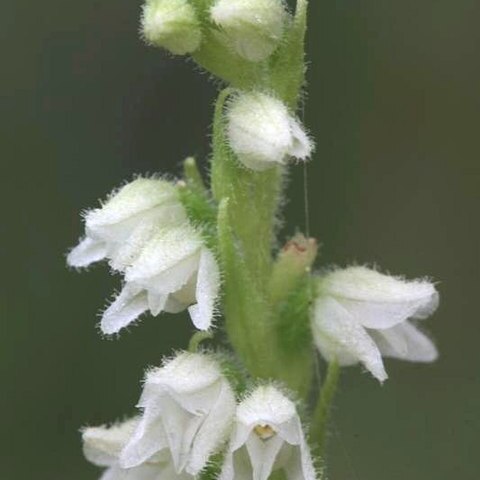Herbs, terrestrial, rhizomatous, scapose, glabrous except for rather sticky, multicellular hairs on peduncles, bracts, sepals, and ovaries. Roots arising from nodes of rhizome, fibrous. Stems erect, with rosette of leaves, not succulent. Leaves evergreen, more than 1, in basal rosette, petiolate; blade commonly marked with white to pale green. Inflorescences terminal, 5–72-flowered spikes, erect; peduncles with sheathing bracts. Flowers resupinate, white, sometimes tinged green, ivory, or brown, sessile; sepals distinct, nearly equal; dorsal sepal and petals forming hood; lip free from column, fleshy, base concave to saccate, apex ligulate or pointed; anther 1, erect or inflexed; pollinia 2, sectile; rostellum notched or 2-pronged. Fruits capsules, erect, dehiscing along 3 ribs.
Upper sep and lateral pet adherent by their margins to form a concave galea extending forward over the lip; lateral sep free, scarcely spreading except at the tip; lip shorter than the galea, ± strongly saccate or pouch-like at base, prolonged distally into a horizontal or deflexed beak; column short, bearing the anther on its back below the usually bifid rostellar tip; pollinia 2; perennial, forming new rosettes by budding from creeping rhizomes; lvs all basal, often white-reticulate, in ours narrowed to a broadly petiolar base; scape bracteate, terminating in a raceme of white or greenish fls; our spp. all with glandular hairy scape and infl, the lateral pet thin, white, differing in texture from the dorsal sep to which they adhere. 25+, cosmop.
Evergreen, terrestrial orchids with thick, fleshy stems. Leaves large, stalked, thin-textured, spreading in a loose, ascending rosette. Inflorescence terminal on a stem, spicate, fleshy, glabrous. Flowers resupinate, relatively large, crowded, hairy, dull-coloured. Dorsal sepal cucullate, overlapping petals to form a galea. Petals thin, brittle, translucent. Lateral sepals free, erect beside the labellum. Labellum unlobed or obscurely lobed, deeply pouched; basal sac containing glandular hairs. Pollinia 2, attached by caudicle to viscidium (often abortive).

